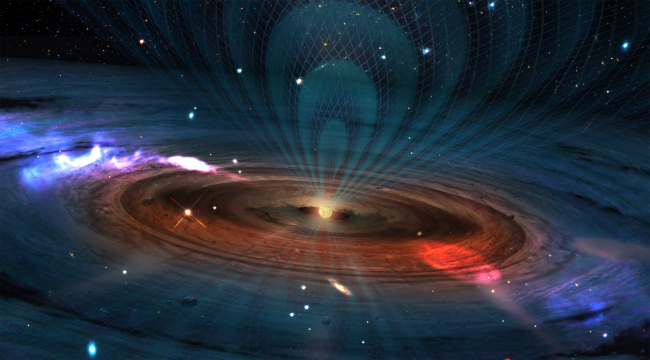
iStockphoto
A renowned theoretical cosmologist recently addressed the theory some theoretical physicists believe, that our entire universe is merely an illusion, or, a hologram. (By the way, a cosmologist is “someone who studies the nature and origin of the universe.” Not to be confused with a cosmetologist, a “person whose job is to improve the appearance of a customer’s face, hair, or skin using makeup and beauty treatments.”)
Paul M. Sutter, a science educator and a theoretical cosmologist at the Institute for Advanced Computational Science at Stony Brook University, writes in an article for Popular Mechanics…
The trouble began with those bothersome boogeymen of the cosmos, black holes. On the surface (and careful readers will be rewarded later with the realization that this is a pun), black holes are simple; stuff falls in and never gets out. All the information about that stuff gets locked away behind the event horizon, never to be seen again. But in the 1970s, famed astrophysicist Stephen Hawking realized that black holes aren’t entirely black. They’re a little gray and a little leaky, emitting a tiny amount of radiation, which causes black holes to evaporate slowly, but inevitably, from existence altogether.
However, that radiation carries no information with it, which brings up a nasty paradox: information goes in, but doesn’t come out, and then the black hole goes away. So what happened to all the information?
The Holographic Principle, according to NASA, “states that there is a maximum amount of information content held by regions adjacent to any surface. Therefore, counter-intuitively, the information content inside a room depends not on the volume of the room but on the area of the bounding walls.”
Confused? Understandable. Maybe this video will help.
The key here is that while a hologram may appear to look like it is three dimensional, it only requires a two-dimensional surface to exist, like those images you have probably seen on credit cards and driver’s licenses.
Black holes are similar in that their information seems to be encoded on their two-dimensional surfaces, not in its three-dimensional volume.
It is this concept that leads theoretical physicists to hypothesize that the same could be true for our whole universe.
“So in other words, the holographic principle may be telling us that quantum interactions living on the borders of our universe literally manifest spacetime within it,” Sutter writes.
“If this is correct, then what we perceive to be a three-dimensional universe, filled with interesting and fun objects interacting through gravity, is really a two-dimensional surface filled with exotic quantum shenanigans from which all else emerges.”
He then adds, “That’s a big if.”
The bottom line, he says, is that “some physicists have already gone all the way, stating that our reality is an illusion, that what we perceive as space and time and gravity are just manifestations of a deeper reality existing in fewer dimensions—that our universe is, quite literally, a hologram.
“But mathematical solutions to physical theories do not necessarily dictate reality. One could just as easily argue that, if the holographic principle turns out to be useful, then we have merely discovered a powerful—and even vital—mathematical tool for understanding our universe. But that doesn’t mean that what the math tells us is real.”
Now, if all of that isn’t enough to sufficiently blow your mind, some other scientists believe there is a 50 percent chance we are actually just living in a simulation.